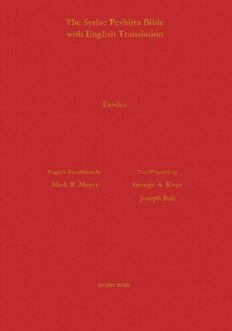
The Syriac Peshiṭta Bible with English Translation. Exodus. PDF
Preview The Syriac Peshiṭta Bible with English Translation. Exodus.
THE ANTIOCH BIBLE The Syriac Peshiṭta Bible with English Translation Exodus Ṣurath Kthobh Editors George Anton Kiraz Andreas Juckel The Syriac Peshiṭta Bible with English Translation Exodus English Translation by Mark Meyer English Translation by Text Prepared by Text Prepared by Mark R. Meyer George A. Kiraz George Anton Kiraz Joseph Bali Joseph Bali 9 34 2017 Gorgias Press LLC, 954 River Road, Piscataway, NJ, 08854, USA www.gorgiaspress.com Copyright © 2 0 1 7 by Gorgias Press LLC All rights reserved under International and Pan-American Copyright Conventions. No part of this publication may be reproduced, stored in a retrieval system or transmitted in any form or by any means, electronic, mechanical, photocopying, recording, scanning or otherwise without the prior written permission of Gorgias Press LLC. 2017 ܐ 9 ISBN 978-1-4632-0536-2 Printed in the United States of America Rev. Dr. Sidney H. Griffith, S. T. Gifted professor, trusted mentor, and dear friend, to whom I owe my appreciation for all things Syriac. May the Lord lavishly reward you for your inestimable investment in me. Mark R. Meyer TABLE OF CONTENTS Table of Contents .................................................................................... v Foreword to the Edition ....................................................................... vii George A. Kiraz Making of the Text ................................................................................. vii Orthographic Diversions from Mosul ................................................ viii Text Organization .................................................................................... ix Acknowledgments..................................................................................... x Abbreviations .......................................................................................... xi Introduction to the Translation .......................................................... xiii Mark R. Meyer The Peshiṭta ............................................................................................ xiii The Book of Exodus ............................................................................. xiv Translation Policy ................................................................................... xv Footnotes Added to the Translation .................................................... xv Translation Technique........................................................................... xvi Syriac Translations Reflecting Hebrew Variants ................................. xx Inner-Syriac Corruptions ....................................................................... xx Syriac Translations that Elucidate the Hebrew ................................... xx Palestinian Jewish Influence on Peshiṭta Exodus ............................... xx Names ...................................................................................................... xxi Translator’s Acknowledgments ............................................................ xxi Addendum 1: Syriac Translations Reflecting Hebrew Variants ....... xxi Addendum 2: Inner-Syriac Corruptions ............................................ xxii Addendum 3: Syriac Translations that Elucidate the Hebrew ....... xxiii Addendum 4: Peshiṭta Exodus Readings Based on Exegetical Traditions in Common with the Targums .............................. xxiv Appendix 1: Versification .................................................................. xxix Appendix 2: Variant Readings .......................................................... xxxi Appendix 3: Names ......................................................................... xxxvii Common Syriac Proper Names ...................................................... xxxvii Replacement ..................................................................................... xxxviii Initial Positions ................................................................................. xxxviii Medial Positions ................................................................................. xxxix Endings ..................................................................................................... xl V VI Table of Contents Bibliography .......................................................................................... xliii Lexica and Dictionaries ........................................................................ xliii Reference ............................................................................................... xliii General Interest .................................................................................... xliii Text and Translation ............................................................................... 1 FOREWORD TO THE EDITION BY GEORGE A. KIRAZ The primary objective of this edition is twofold: to provide a reliable text for scholars and students who are looking for a fully vocalized Syriac text and to make available to religious communities, for whom this text is sacred, an English translation that can be used in various religious and cultural settings. As such, one had to navigate carefully between rigid scholarly principles and practical editorial choices. Making of the Text The current edition provides a West Syriac version of the 1887–91 Peshiṭta Mosul text.1 While the Mosul text was prepared based on second millennium manuscripts, its text is substantially attested by manuscripts belonging to the first millennium. As ancient MSS are rarely vocalized, our text relies on the vocalization of the Mosul edition. In addition to full vocalization, our text is supplemented with complete Rukkākhā and Quššāyā pointing and other orthographic markings, keeping in mind the general orthographic principles adopted by Pusey and Gwilliam in their 1901 Tetraeuangelium.2 Hence, while the consonantal tier is substantially ancient, the vocalism and orthographic tiers are quite late. As the Mosul edition did not fully mark Rukkākhā and Quššāyā, these points were added and a regular expression3 was applied to the text to 1 Clemis Joseph David (ed.), The Syriac Bible According to the Mosul Edition, 3 volumes, with an introduction by Sebastian P. Brock (Piscataway, NJ, 2010), a reprint of the Mosul 1887–91 edition titled ܐܬܛܝܫܦ ܐܝܪܩܬܡܕ ܐܬܩܦܡ ܟܝܐ ܒܬܟ ܬܪܘܨ. 2 P. E. Pusey and G. H. Gwilliam, Tetraeuangelium Sanctum, the Fourfold Holy Gospel in the Peshitta Syriac Version with Critical Apparatus, with an introduction by Andreas Juckel (Piscataway, NJ, 2003), a reprint of the 1901 edition. 3 In computing, a regular expression provides a mechanism with which strings of text can be matched with a search criterion. In most notations, a bracket expression matches a single character inside that bracket (e.g., [ab] matches a single a or b). The exclamation mark denotes negation. Hence, the expression [bgdkpt][!RQ] (where R and Q represent the VII
